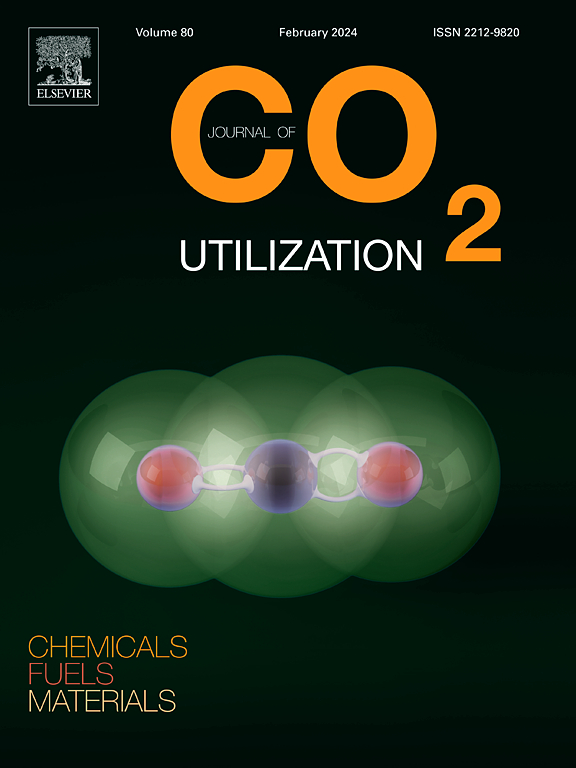通过结构掺杂调整TiO2光催化剂的CO2还原选择性
IF 7.2
2区 工程技术
Q1 CHEMISTRY, MULTIDISCIPLINARY
引用次数: 0
摘要
本研究探讨了不同结构掺杂剂对tio2的影响,以提高光催化CO 2还原反应产物的选择性。具体来说,研究了氮掺杂、铂表面掺杂和Ti³ +离子自掺杂(通过还原TiO₂-x中的氧空位)的影响。x射线衍射证实为锐钛矿相,晶体尺寸为24 ~ 27 nm。高分辨率透射电镜显示,掺杂铂的tio2表面有均匀分布的活性位点。氮掺杂选择性地稳定了氧空位,提高了CO的产量,而铂的负载则起到了电子陷阱的作用,改善了电荷分离,促进了CO₂更深层次地还原为CH₄。Ti³ +离子的自掺杂引入了结构缺陷,进一步影响了光催化动力学。x射线光电子能谱和电子顺磁共振分析证明了这些掺杂剂如何重组表面缺陷,从而微调产品的选择性。不同的掺杂氧比和较小的晶体导致不同的CO和CH₄产率,强调了掺杂类型和分布的重要性。稳定性测试证实了在多个循环中一致的光催化活性,突出了改性材料的坚固性和可重复使用性。该研究为掺杂剂、晶体结构和光催化性能之间的相互作用提供了有价值的见解,为设计选择性CO 2还原的定制催化剂提供了新的方向。本文章由计算机程序翻译,如有差异,请以英文原文为准。
Tuning CO2 reduction selectivity via structural doping of TiO2 photocatalysts
This study explores the effects of various structural dopants on TiO₂ to enhance selectivity of reaction products in photocatalytic CO₂ reduction. Specifically, the impacts of nitrogen doping, platinum surface doping, and self-doping with Ti³ ⁺ ions (via oxygen vacancies in reduced TiO₂-x) were investigated. X-ray diffraction confirmed the anatase phase, with crystal sizes ranging from 24 to 27 nm. High-resolution transmission electron microscopy revealed uniformly distributed active sites on platinum-doped TiO₂ surfaces. Nitrogen doping selectively stabilized oxygen vacancies, enhancing CO production, while platinum loading acted as an electron trap, improving charge separation and promoting the deeper reduction of CO₂ to CH₄. Self-doping with Ti³ ⁺ ions introduced structural defects that further influenced photocatalytic dynamics. X-ray photoelectron spectroscopy and electron paramagnetic resonance analyses demonstrated how these dopants reorganize surface defects, thereby fine-tuning product selectivity. Variations in dopant-to-oxygen ratios and smaller crystallites led to different yields of CO and CH₄, emphasizing the importance of dopant type and distribution. Stability tests confirmed consistent photocatalytic activity across multiple cycles, highlighting the robustness and reusability of the modified materials. This study provides valuable insights into the interplay between dopants, crystal structure, and photocatalytic performance, offering new directions for the design of tailored catalysts for selective CO₂ reduction.
求助全文
通过发布文献求助,成功后即可免费获取论文全文。
去求助
来源期刊

Journal of CO2 Utilization
CHEMISTRY, MULTIDISCIPLINARY-ENGINEERING, CHEMICAL
CiteScore
13.90
自引率
10.40%
发文量
406
审稿时长
2.8 months
期刊介绍:
The Journal of CO2 Utilization offers a single, multi-disciplinary, scholarly platform for the exchange of novel research in the field of CO2 re-use for scientists and engineers in chemicals, fuels and materials.
The emphasis is on the dissemination of leading-edge research from basic science to the development of new processes, technologies and applications.
The Journal of CO2 Utilization publishes original peer-reviewed research papers, reviews, and short communications, including experimental and theoretical work, and analytical models and simulations.
 求助内容:
求助内容: 应助结果提醒方式:
应助结果提醒方式:


